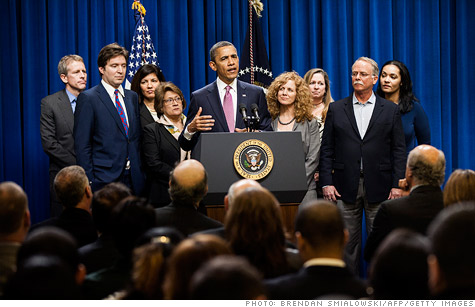
President Obama gathered millionaires and their secretaries at the White House this week to drive home his push for the Buffett Rule.
NEW YORK (CNNMoney) -- A lot gets lost in the rhetoric about the Buffett Rule, which would impose a minimum 30% tax on millionaires.
And at the top of the list is this fact: Most millionaires already pay higher effective tax rates than just about everyone else.
Certainly, many people who earn at least $1 million a year pay an effective rate of less than 30%. But they still pay a higher percentage than most people further down the income ladder.
Broadly speaking, the effective tax rate is the percentage of your income that you pay in taxes. The rate can be measured several ways.
For example, using a very broad measure of income, and counting federal income and payroll taxes, the average effective federal tax rate for people making between $40,000 and $50,000 was 12% last year, according to estimates from the Tax Policy Center, an independent research group.
By contrast, the rate for those making more than $1 million was 20.1%.
The difference is even starker if you strip out the payroll tax and look just at income tax liability. Those in the middle-income group had an effective rate of just 3.2%. Millionaires paid 18.9%.
In both of those scenarios, the Tax Policy Center counted gross income plus less obvious sources of compensation, such as the employer share of a workers' payroll taxes.
But an even narrower measure of income -- adjusted gross -- yields similar results.
In 2009, among people who paid taxes, those making between $30,000 and $50,000 paid an average tax rate of 6.4% looking at income tax liability alone, according to IRS data. Millionaires paid 24.6%.
Averages, of course, don't tell the whole story.
That's because any two taxpayers within an income group can end up paying very different rates, depending on how they earn their income and which tax breaks they qualify for.
The Buffett Rule would level the playing field a bit among millionaires.
Consider two millionaires. One earns most of her income as a highly paid executive, and the other gets the bulk of her income from her investment portfolio.
Currently, the executive pays a much higher effective rate than the investor because her paycheck is taxed at the top rate of 35%. She would also owe payroll taxes on her income.
The investor, by contrast, pays just 15% on her long-term gains and dividends. She pays 0% if she invests in tax-free bonds. And at least until next year, she owes no payroll taxes on her investment income. (In 2013, however, she would be expected to pay Medicare taxes.)
For its part, the Obama administration argues that the Buffett Rule is targeted at those millionaires -- like the full-time investors -- who can structure their income to greatly minimize their tax bite.
The White House estimates that 22,000 households with incomes higher than $1 million paid less than 15% of their income in income taxes in 2009. And a very small number of them ended up owing nothing at all -- fewer than 1,500 that year, according to the IRS.
But that doesn't mean the Buffett Rule wouldn't also hit other millionaire households that already pay a much higher effective rate than other Americans, just not as high as the new 30% minimum.
All told, the Tax Policy Center estimates that about one-third of the richest would pay higher taxes under the Buffett Rule in 2015 than they do today. ![]()

Carlos Rodriguez is trying to rid himself of $15,000 in credit card debt, while paying his mortgage and saving for his son's college education.
| Overnight Avg Rate | Latest | Change | Last Week |
|---|---|---|---|
| 30 yr fixed | 3.80% | 3.88% | |
| 15 yr fixed | 3.20% | 3.23% | |
| 5/1 ARM | 3.84% | 3.88% | |
| 30 yr refi | 3.82% | 3.93% | |
| 15 yr refi | 3.20% | 3.23% |
Today's featured rates: